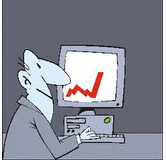HOW FEELING FROGGY IN THE MARKETS LEADS TO BEATDOWNS
As we approach the 13,000 level on the Dow, in the process breaking up and through the generational resistance point I have been discussing for the past few weeks, it is important to take note of what has been working in this bull market. In fact, this is what works in most all bull markets. No rocket science involved. In fact, not much of anything involved except for one thing. That one thing is having common sense enough to realize what the current condition of the market is and sit tight in positions that reflect the condition. Bull markets, with the exception of 1999, are not meant to be traded furiously. They are not meant to be guessed, poked and prodded for weakness. By that I mean the constant fascination and obsession with making sure you don't get hit with a pullback, giving into some short-term pain. Short-term pain is part of being in a bull market. There are very few that can guess what the correct time will be to initiate hedges to counter any short-term pain they may experience at the hands of the market. It's a game that should be avoided at all costs. We are in a time and place where the abundance of information at an investor's fingertips literally makes it seem perfectly acceptable to feel froggy in the markets, jumping from place to place. Excess trading activity is after all reflective of the increased volume of information. Excess information and the activity resulting from the digestion of that information is only normal. In the end what all of that noise amounts to is confusion. You have a thousand competing angles in your head when only one angle should matter. That is at what angle the current uptrend or downtrend is proceeding. In all likelihood, a breakout over 13,000 will occur soon. I think that breakout will fail. That doesn't mean you should hedge your exposure or move into 100% cash. If you want to trim some positions, be my guest. It's probably a prudent decision. Even if we are at a point where we are putting a substantial top (highly unlikely, by the way) you will have plenty of opportunity and fair warning to get out of the way. Tops - especially after the kind of run we have had - are a process. I haven't come across one major top in roughly 18 years of grinding that hasn't given whomever wanted to liquidate multiple opportunities to do so. If you're feeling froggy, go to the gym and jump rope. It will be cheaper and better for you than jumping from place to place in...
BUYING SHARES OF NYX FOR RETIREMENT ACCOUNTS
It is fair to say that shares of NYX (NYSE Euronext) will be sensitive to bull and bear cycles. It is a company that derives its revenues from the trading and access to various types of securities on a daily basis. In fact, between all the exchanges NYX owns globally, roughly one-third of all global equity trades are made through one of their exchanges. It is the largest such entity in the world. It popped up on my radar screen as a result of the tremendous amount of insider buying taking place in the company recently. Most impressive is the seven figure buy that took place by the Deputy Chairman of the company earlier this week. The per share price has declined significantly since last year when a merger was announced with Deutsche Boerse. That merger has since been dumped by European regulators and is no longer in the picture. While the shares have recovered from their 2011 lows of roughly $22 per share, they are nowhere near their $41 high of 2011 and a long ways from the all-time of $112 made in 2006. The future share appreciation in this company comes down to market environment...plain and simple. It is essentially a play on whether the global markets will be accommodating towards investors or hostile. An accommodating market sees increased volumes, participation and opportunities that will be reflected in the share price of NYX. A hostile market will, obviously, hurt the prospects of a company that deals directly with equity trading more than most other entities. In the meantime, the company is extremely shareholder friendly. It has a 4% yield, which always helps with the process of waiting around for a company to experience capital gains. They have been in the process of buying back shares for sometime now and recently announced another $550 million to be allocated towards share buybacks. Here is a technical look at the company: click chart to enlarge On a fundamental basis, all valuation measures point to opportunity. It trades at one times book value and 10 times forward earnings. They also sport some extremely fat margins that should remain consistent over the long-term. All of this is for a global leader in its respective sector, keep in mind. NYX is a long-term buy with a time horizon of 5 years plus at a minimum. I am purchasing it for retirement and conservative accounts only. Let it sit and forget type...
QUICK THOUGHTS
There isn't much to take away from the current market action. We are up against the generational resistance point I have been speaking about for a couple weeks on the Dow. What the major averages are forming is a narrow consolidation against the highs on declining volume. This is picture perfect behavior, foretelling a near-term attempt at a breakout over 13,000 on the Dow. I have again been saying for weeks that I think the first attempt at 13,000 will fail and a multi-week correction will start from that point. The correction will not exceed 5% until, I believe, late spring or summer. If the market continues to rise from 13,000, without an initial failure, then this market is far stronger than anyone thinks. It would qualify as a major breakout on a long-term time frame. Keep your mind open to that possibility. I scan every night for new buy candidates. As you probably already know, I am selective in what I choose to profile here. In fact, I am being much more selective with long positions now than I was at any point last year. It only takes a few big winners each year to have a monster year. No need to be impatient. The opportunities always come. As they become apparent, I will profile them here. I wish I could provide a dog and pony show that would knock your socks off tonight. If I did, however, it would probably wouldn't help you and would cause me to lose money. So I'll keep it simple and short. Less is more. Simplicity is genius. Both ring true in the current state of the...
A FASCINATING INTERPRETATION OF THE PUT/CALL RATIO: VOLUME 3
Misinterpretations of sentiment indicators are common in today's market. Traders have become accustomed to looking at raw data for these indicators, without any respect for historical reference. The put/call ratios can be extremely effective if smoothed out and viewed from a relative basis. You do that by using moving averages instead of raw data and zooming out. Today we take a look at the equity put/call ratio. Traders like to refer to this as a "dumb money" indicator. This comes from the idea that smaller, retail investors enjoy getting involved in equity options and professionals tend to gravitate towards index options. I am not sure that there is a "dumb money" class left in this market. When even the small pockets of retail investors have a general grasp of contrarian theory, the act of fading the next guy becomes an exercise in futility. It's like the story of a hedge fund manager that goes to an investment conference and the first question the presenter asks, "How many of you in this room are contrarians?" 80% of the attendees raise their hands. The chart below displays the 20 day and 100 day moving average of the equity put/call ratio only. The bottom graph displays the S&P 500. I have marked important, multi-month tops with the vertical blue lines. You can see that there seem to be some definite requirements of where the 100 day moving average needs to go before important tops in the market are observed. This becomes all the more pronounced following periods of excess pessimism that are marked by important tops in the 100 day moving average of the equity put/call. I have highlighted those tops with a green box. The conclusion here is that the bears may have a lot more waiting to do before a top of any significance is observed. click chart to...
6 CHARTS THAT WILL HELP YOU MAKE FRIENDS AND INFLUENCE PEOPLE IN THE WEEK AHEAD
click chart to enlarge
CLINGING TO ANALYSIS THAT HAS BEEN PROVEN WRONG IS A DEADLY DISEASE
It's easy to get caught up in all the noise that is the countless number of gauges investors use to measure the markets. What investors forget amidst the mental circus that comes of deep market analysis is that it is NEVER the indicator or data that matter. The only matter of any substance is how the market reacts to that indicator or data. I am reminded of this daily recently as I see seemingly smart market participants clinging onto data points that lost their relevancy weeks or months ago. It's like that guy you see walking down the street with long, bleached blond hair, netted gloves, leather pants and a Motley Crue T-Shirt. You can see that he is clinging on for dear life to the 1980's as that was the only period that worked for him. He doesn't realize that it doesn't, hasn't and won't work again. Move on. It doesn't matter the gauge. I have seen investors cling onto valuation measures such as P/E ratios, various gauges of cash flow and relative value comparisons as fervently as the guys who cling onto technical measures that have stopped working. Value traps are built off of investors who can't let go of the fact that while their ratios say the stock is a buy, the market is not in the mood to pay attention. When the market isn't in the mood to pay attention, what you consider brilliant analysis is no better than using the mating patterns of Tibetan Antelopes to gauge whether a stock is a buy or sell. What is worse than all are those who cling onto technical information that they gauge as being favorable to their position and simply can't let go. What is dangerous about technical analysis to the average investor - who doesn't have bullshit goggles that come with years of experience - is that technical's are extremely subjective. You can twist around any technical indicator to say what you want, when you want. Therefore, if an indicator isn't responding to the market, an investor can contort that indicator to correspond to his or her bias. In the end the gauge you are using to determine your investment bias is only relevant if the market recognizes it as such. There is nothing in the markets playbook that says your particular brand of analysis must be respected. There is also nothing in the markets playbook that says your brand of analysis doesn't open you up to the risk of ruin. This is a subjective game that we play on a daily basis, with a dangerous and fickle opponent. Your ability to adjust is all...
THE MARKET IS SHOWING RESPECT TO AN IMPORTANT LEVEL OF RESISTANCE. NOW WHAT?
Today's move down more than likely marks a beginning rather than any conceivable end. It's the beginning of the market taking its foot off the proverbial gas pedal in favor of a consolidation or a pullback not to exceed 5% from the recent highs. You can see in the daily chart posted below that the Dow is showing a tremendous level of respect for the generational trendline/resistance point I discussed a couple nights ago. This is a sign of short-term weakness for the average. What makes it more decisive is the fact that the markets gapped down off of this resistance area. When you have momentum that develops off of such an important level it just shows that the market is paying all the more attention to it. click chart to...
THE POWER OF GENERATIONAL TRENDLINES AND WHAT THEY MEAN FOR THE CURRENT MARKET
I speak about generational trendlines now and then. I define them as trendlines that exert their influence over long periods of time that span multiple investing generations. These trendlines can often have origins that go back many decades. When the S&P was battling with the 1230 level from August until nearly the end of 2011, there was a generational trendline sitting right in the middle of that range dating back to the early 1970's. That trendline marked the bottom for the 1987 crash. The bottom for the 90/91 market that saw the "tech boom" kickoff soon thereafter. Its influence was obviously felt during the second half of 2011 as the 1230 level was a consistent battle zone between the bulls and the bears. The Dow has been battling the same types of generational trendlines since the 2011 top. The origins of the pink trendline that you see in the chart below go back to the 1930's for the Dow. This trendline marked the 1966 top that led to a 15 year sideways range for the Dow. It marked the 2003 low that saw the markets rise into the 2007 top. These trendlines should never be used as absolute points of support or resistance. Rather they should be used as guideposts or benchmarks to gauge how strong or a weak a market is currently. Think of them as 100 pound dumbbells that the market has to lift. If the market lifts the dumbbell with ease, meaning that it breaks out over a generational resistance line, as an example, then the market can be deemed as strong. If, however, the market breaks down violently off of the generational trendline, then the market can be deemed as being weak since it dropped the weight. You can see in the chart below we are right up on the pink trendline and consolidating below it. This leads me to believe that the Dow wants to break up through the trendline, above 13,000. You can see that the Dow had three counterfeit moves about the generational trendline in 2011 before breaking down severely. This was much like the three counterfeit moves below the trendline that I outlined in the "Most Important Chart I've Ever Posted" posting in mid-December. It could be that the Dow wants to break up through the trendline and then break down for a correction before trying to move up in a substantial manner later this year. It could also be that the Dow simply breaks up through the generational trendline and accelerates, not looking back. The latter scenario is highly bullish. Highly bullish doesn't do it justice. It is a monstrously...
HOW SHORT-TERM TRADING CAN LEAD TO XANAX DEPENDENCE AND A FASCINATION WITH CZECHOSLOVAKIAN HOOKERS
If there is anything that should have become obvious to even the most casual market observer it is that the current investor class has been sealed in a mindset that believes reversion to the mean is a normal function of the financial markets. That means that a rally must always be met with a pullback of some substance that creates the choppy trading environment most traders have become accustomed to over the past several years. The truth of the matter is that a majority of traders (hedge fund managers and individual investors included) missed out on the 2009 bottom. By the time their raisin balls had grown into the standard issue testicles the in the 3rd - 4th quarter of 2009 the rally started becoming choppy. In the first half of 2010 we had the flash crash. And then a devious trading range developed until QE2 was announced sending the markets rocking higher. We just came out of 2011, which was on par with 2008 in terms of fear created and the potential for ruinous economic calamity. This again caused investors to bite into the "I must sell rally" mentality that the market has so brilliantly programmed into the mind of investors so that it can have moves.......like this. Per the usual, the mindset has been fixed on the incorrect prize. That prize sees everything on a short-term basis that is no longer relevant. That prize will cost investors a pretty penny when they do any of the following: 1. Hedge prematurely 2. Sell short in anticipation of a decline 3. Remain in cash for fear of Europe, slowing earnings, World War 3 igniting when Israel attacks Iran, GDP slowing, unemployment rising, a large bank going under, oil going over $110, China crashing etc. You see what we have here is the classic wall of worry. Investors all know about the wall of worry. But when it is staring them right in the face, they fail to realize that it is there. And that is exactly what wall of worries do to investors. They create such anxiety that investors have no doubt that the end is nigh. The fact that markets thrive off of such anxiety doesn't enter the minds of the collective investor class because anxiety doesn't allow it to. And that's what we have here. We have a non-existent individual investor class that is hiding in money markets, CDs and bonds. We have an overrated hedge fund class that is stepping back into the mix but will sell at the first hint of danger. We have a mutual fund class that has seen redemptions cause managers to...









